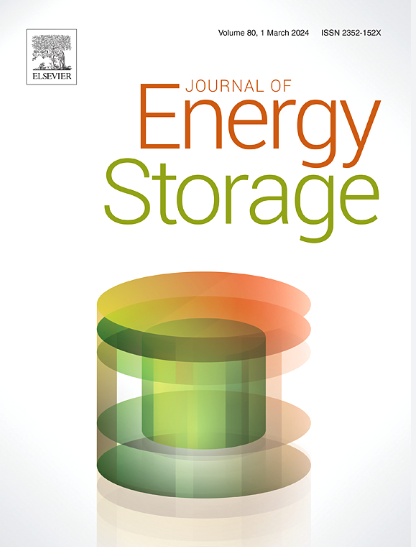尼日尔共和国工业部门提高电力可靠性并网光伏/风能和储能系统的技术经济分析
IF 8.9
2区 工程技术
Q1 ENERGY & FUELS
引用次数: 0
摘要
电力的不可靠性是许多发展中国家面临的主要挑战。要解决这一问题,必须将可再生能源纳入现有电网。尼日尔是西非的一个发展中国家,每天都面临电力短缺,这需要使用柴油发电机来确保运行的连续性。然而,这种解决方案带来了经济和环境方面的挑战。这项工作分析了将光伏/风力发电系统集成到现有不可靠的电网/柴油发电机系统中,以分别为尼亚美和阿加德兹地区的ORIBA JUS和AGHAZARMADRAN两个选定工业提供工业临界负荷的可行性。利用HOMER Pro软件作为优化工具,对光伏/风能并网进行技术经济分析。分析考虑了各种数据,包括临界负荷概况、每年电网中断持续时间和频率以及气象数据。最具成本效益的系统与五种不同的配置进行了比较,包括电网/柴油(基本情况,因为它是已有的系统),电网/柴油/光伏,电网/柴油/光伏/电池,电网/柴油/光伏/电池/风能,电网/柴油/光伏/风能,以及电网/柴油/光伏/风能,以选择每个地区的最佳配置。研究发现,就净当前成本(NPC)和平准化能源成本(LCOE)而言,混合电网/柴油/光伏/风能系统是ORIBA JUS所有各种配置中最具成本效益的。该系统的NPC为1,831,094.00美元,LCOE为0.082美元/千瓦时,比基本情况低0.03美元。该配置的LCOE分别比非高峰和高峰时段的电网电价低0.011美元和0.068美元。AGHAZARMADRAN在Agadez地区的最低成本系统是电网/柴油/光伏/风能,NPC为206,927.60美元,LCOE为0.055美元/千瓦时。该系统的NPC比电网/柴油系统低55%,而LCOE比电网/柴油系统低约0.07美元,降低了50%以上。与电网价格的对比显示,电网/柴油/光伏/风能的LCOE分别比高峰和低需求时的LCOE低0.095美元和0.04美元,因此,在高峰和低需求时,电网价格的LCOE依次降低了约63%和41%。此外,整合可再生能源后,ORIBA JUS和AGHAZARMADRAN的燃料消耗量分别减少了2474升/年和1139.00升/年,而二氧化碳排放量分别减少了33%和76%。结论是,将光伏和风力系统并入尼日尔共和国目前的电网和柴油系统在经济上和环境上都是可行的。本文章由计算机程序翻译,如有差异,请以英文原文为准。
Techno-economic analysis of grid-integrated PV/wind and storage system for electricity reliability enhancement in the industrial sector in Niger Republic
The unreliability of electricity is a major challenge in many developing countries. In handling this problem, renewable energy resources must be integrated into the existing power grid. Niger, a developing country in West Africa, faces daily electricity shortages, which require the use of diesel generators to ensure operational continuity. However, such a solution poses economic and environmental challenges. This work analyzed the feasibility of integrating photovoltaic (PV)/wind power systems into existing unreliable grid/diesel generator systems to supply industrial critical loads of two selected industries, including ORIBA JUS and AGHAZARMADRAN in Niamey and Agadez regions, respectively. HOMER Pro software was utilized as an optimization tool to perform the techno-economic analysis of the grid-integrated PV/wind. The analysis considered various data, including critical load profile, yearly grid outage duration and frequency, and meteorological data. The most cost-effective system was compared with five different configurations, including grid/diesel (base case because it is the pre-existing system), grid/diesel/PV, grid/diesel/PV/battery, grid/diesel/PV/battery/wind, and grid/diesel/PV/wind, to select the optimal configuration for each region. The study found that the hybrid grid/diesel/PV/wind system is the most cost-effective of all the various configurations for ORIBA JUS in terms of the Net Present Cost (NPC) and Levelized Cost of Energy (LCOE). This system has an NPC of $1,831,094.00 and an LCOE of 0.082 $/kWh, which is about $0.03 lower than the base case. Moreover, the LCOE of this configuration is $0.011 and $0.068 lower than the grid electricity price during the non-peak and peak demand periods, respectively. The lowest cost system for AGHAZARMADRAN in the Agadez region is grid/diesel/PV/wind, with an NPC of $206,927.60 and an LCOE of 0.055 $/kWh. The NPC of this system is 55 % lower than the grid/diesel system, while the LCOE is approximately $0.07 lower than the LCOE of grid/diesel, representing over 50 % reduction. Comparison to the grid price, shows that the LCOE of grid/diesel/PV/wind is $0.095 and $0.04 lower than the rate during the peak and the low demands, respectively, thus representing a reduction in LCOE of about 63 % and 41 % for peak and low-demand grid prices in that order. In addition, integrating renewable energy significantly reduced fuel consumption by 2474 l/year for ORIBA JUS and 1139.00 l/year for AGHAZARMADRAN, while the CO2 emissions were reduced by 33 % for ORIBA JUS and 76 % for AGHAZARMADRAN. It was concluded that the integration of PV and wind systems into the present grid and diesel systems in Niger Republic, is economically and environmentally viable.
求助全文
通过发布文献求助,成功后即可免费获取论文全文。
去求助
来源期刊

Journal of energy storage
Energy-Renewable Energy, Sustainability and the Environment
CiteScore
11.80
自引率
24.50%
发文量
2262
审稿时长
69 days
期刊介绍:
Journal of energy storage focusses on all aspects of energy storage, in particular systems integration, electric grid integration, modelling and analysis, novel energy storage technologies, sizing and management strategies, business models for operation of storage systems and energy storage developments worldwide.
 求助内容:
求助内容: 应助结果提醒方式:
应助结果提醒方式:


